Attenuated total reflection-Fourier transform infrared spectroscopy (ATR-FTIR) for quantification of piroxicam in tablet dosage from as a green analytical method
A simple, rapid, precise, accurate, reproducible, economic and eco-friendly analytical method for the quantification
of piroxicam in tablet dosage form, using attenuated total reflectance Fourier transform infrared spectroscopy (ATRFTIR), has been developed. The measurements were based on the ATR technique, wherein there is no sample
preparation, except for pulverizing the tablet, thereby eliminating the use of toxic chemicals or solvents. The calibration
curve of piroxicam was obtained by performing a linear regression analysis, using data from the direct ATR-FTIR
measurement of percentage transmittance (%T), corresponding to the secondary peak at 1526.38 cm-1 in the
concentration (C) range of 25.18-93.63 mg/g. The linear regression equation obtained from the present data was
represented by %T = -0.2178 C + 99.208 and was associated with a coefficient of determination (r2) of 0.998. The
proposed method was validated for piroxicam in tablet form. The relative standard deviation percentage (%RSD) was
found to be less than five, with a recovery percentage in the range of 96.0-99.3 %.
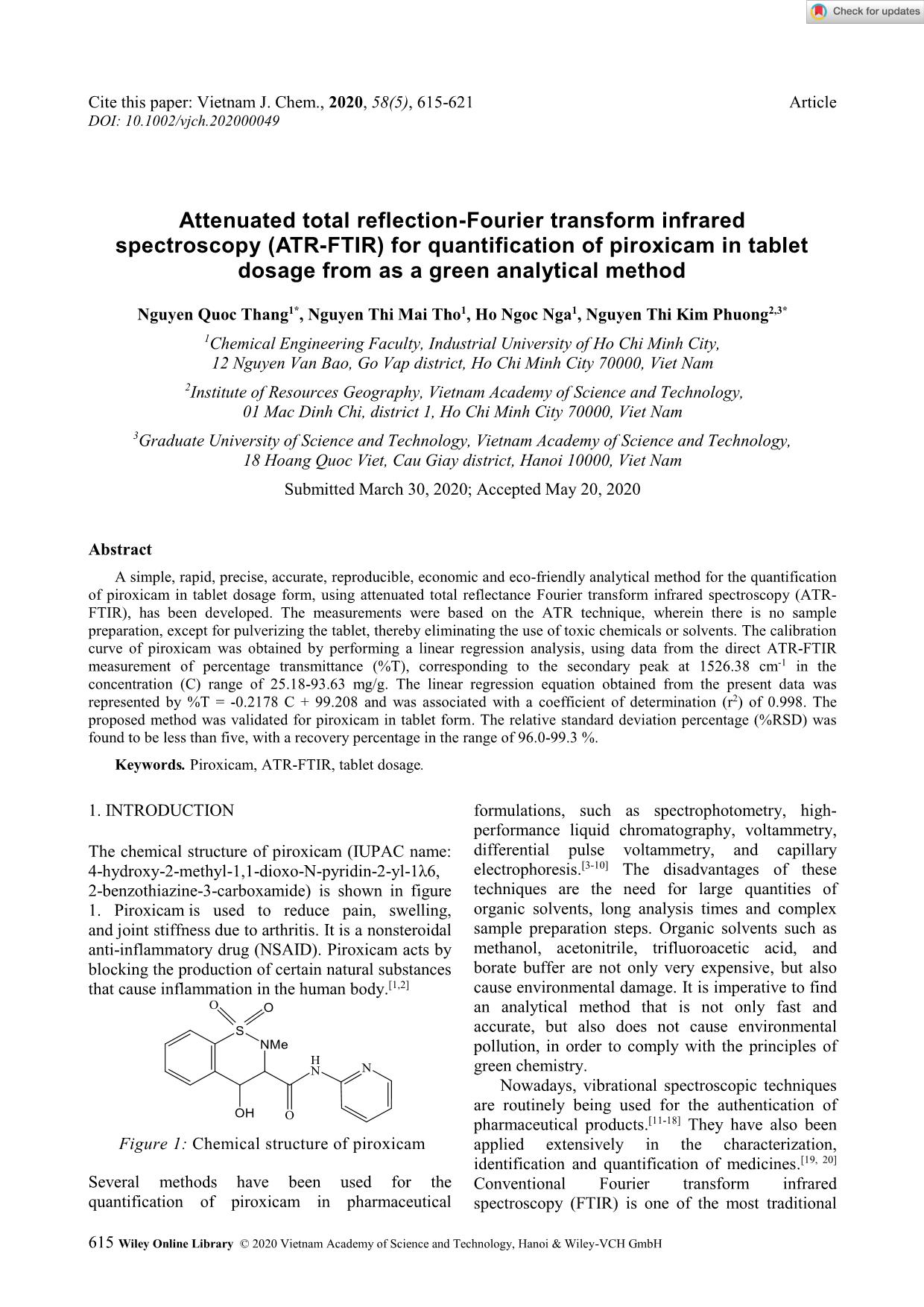
Trang 1
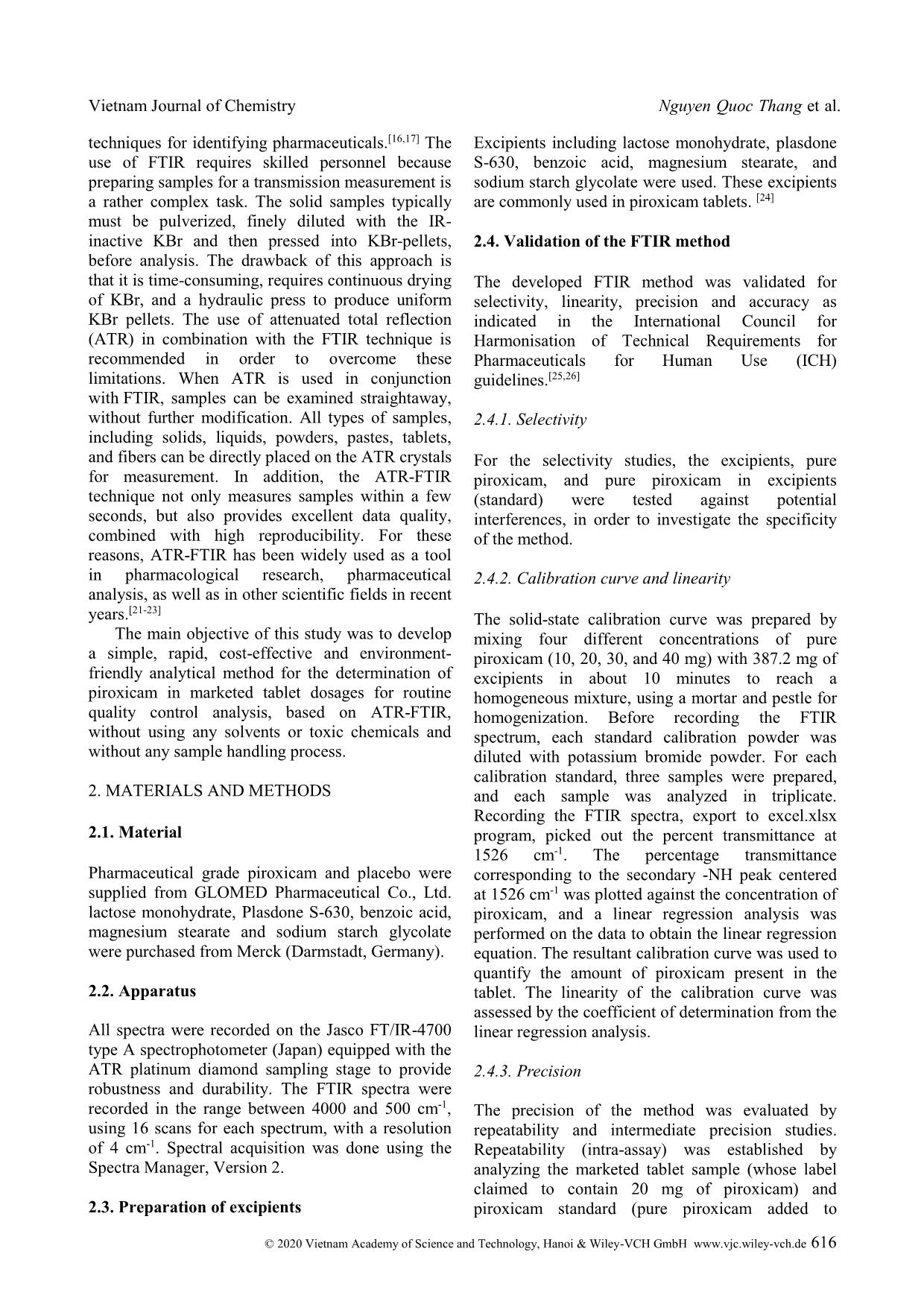
Trang 2
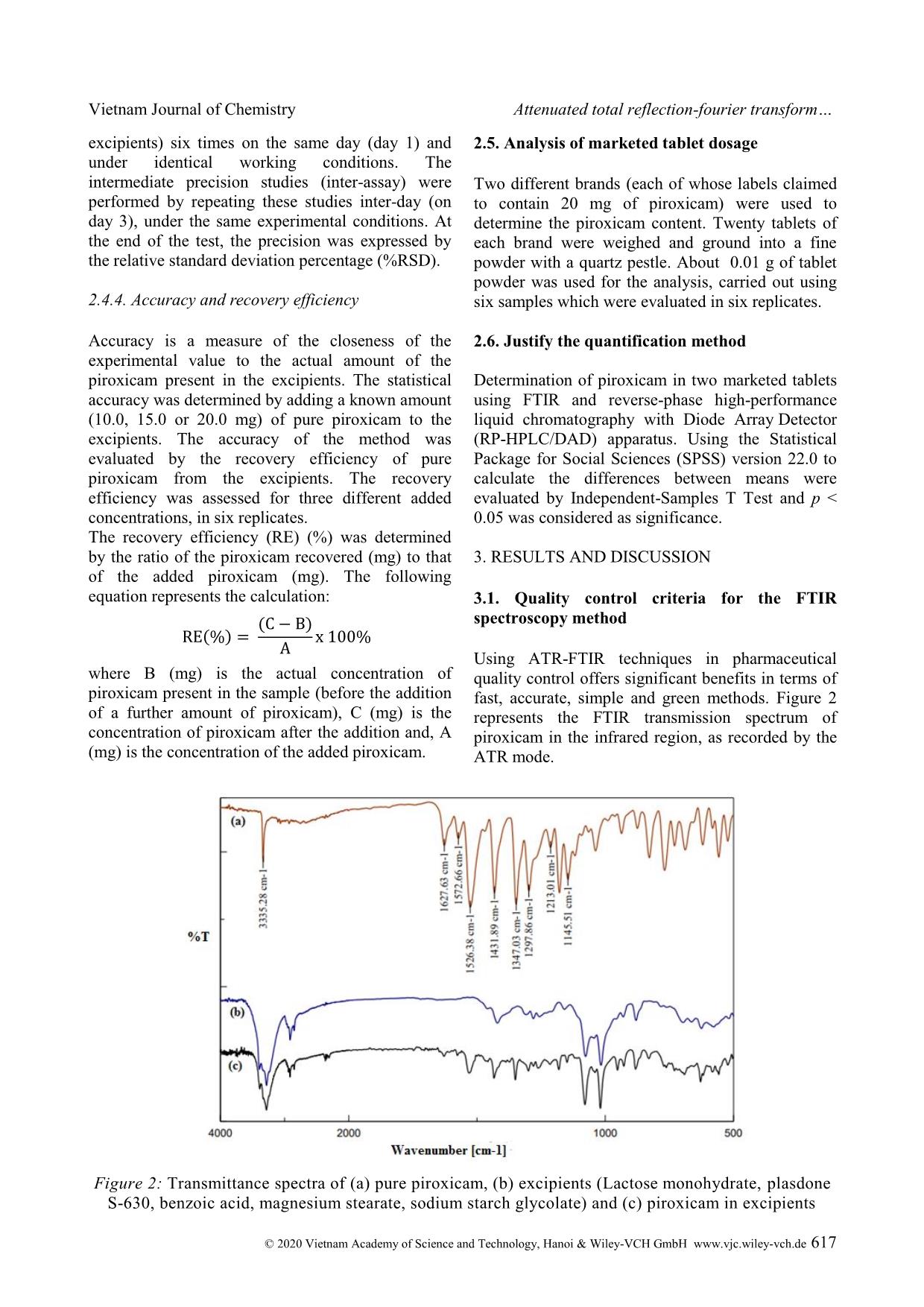
Trang 3
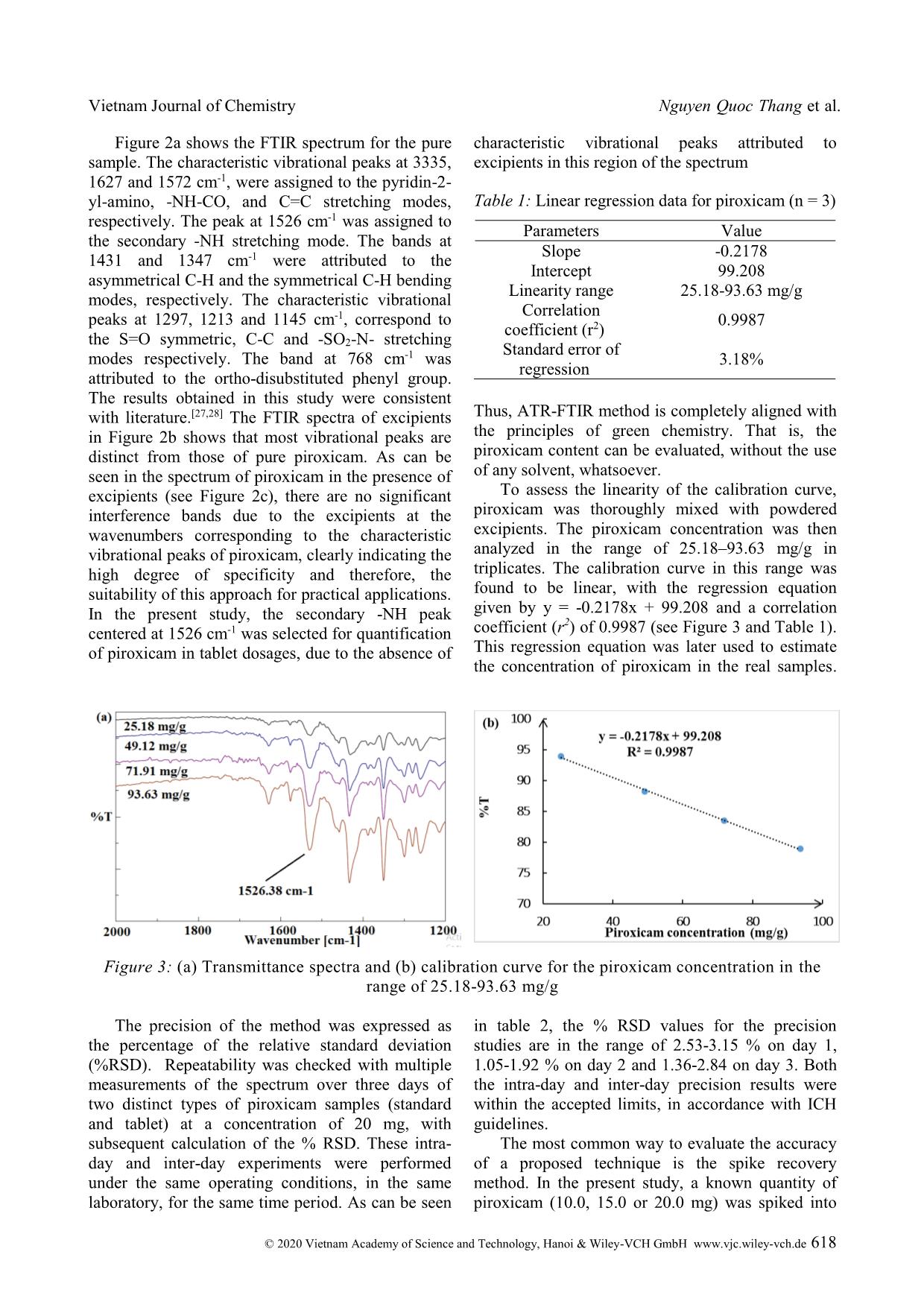
Trang 4
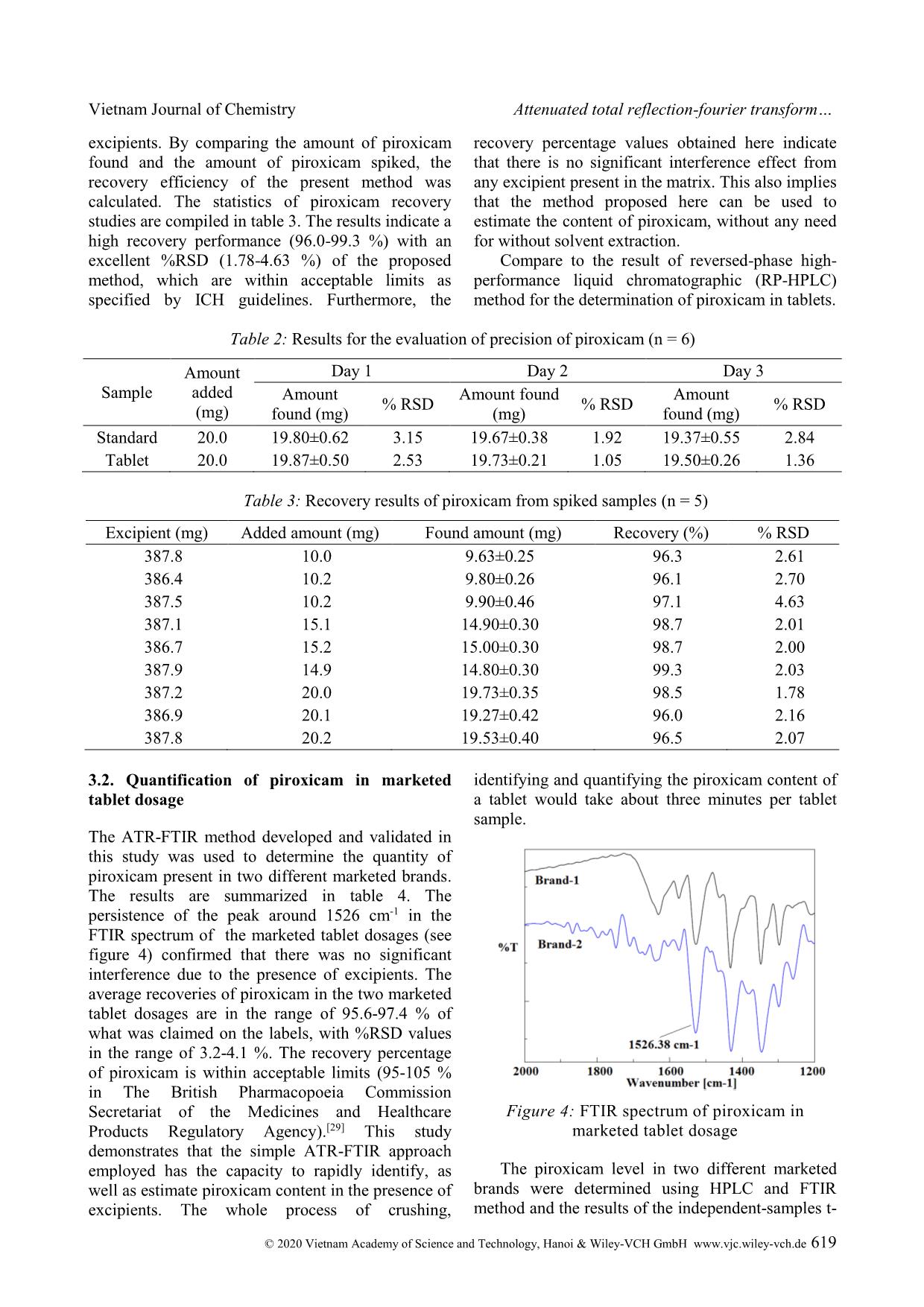
Trang 5
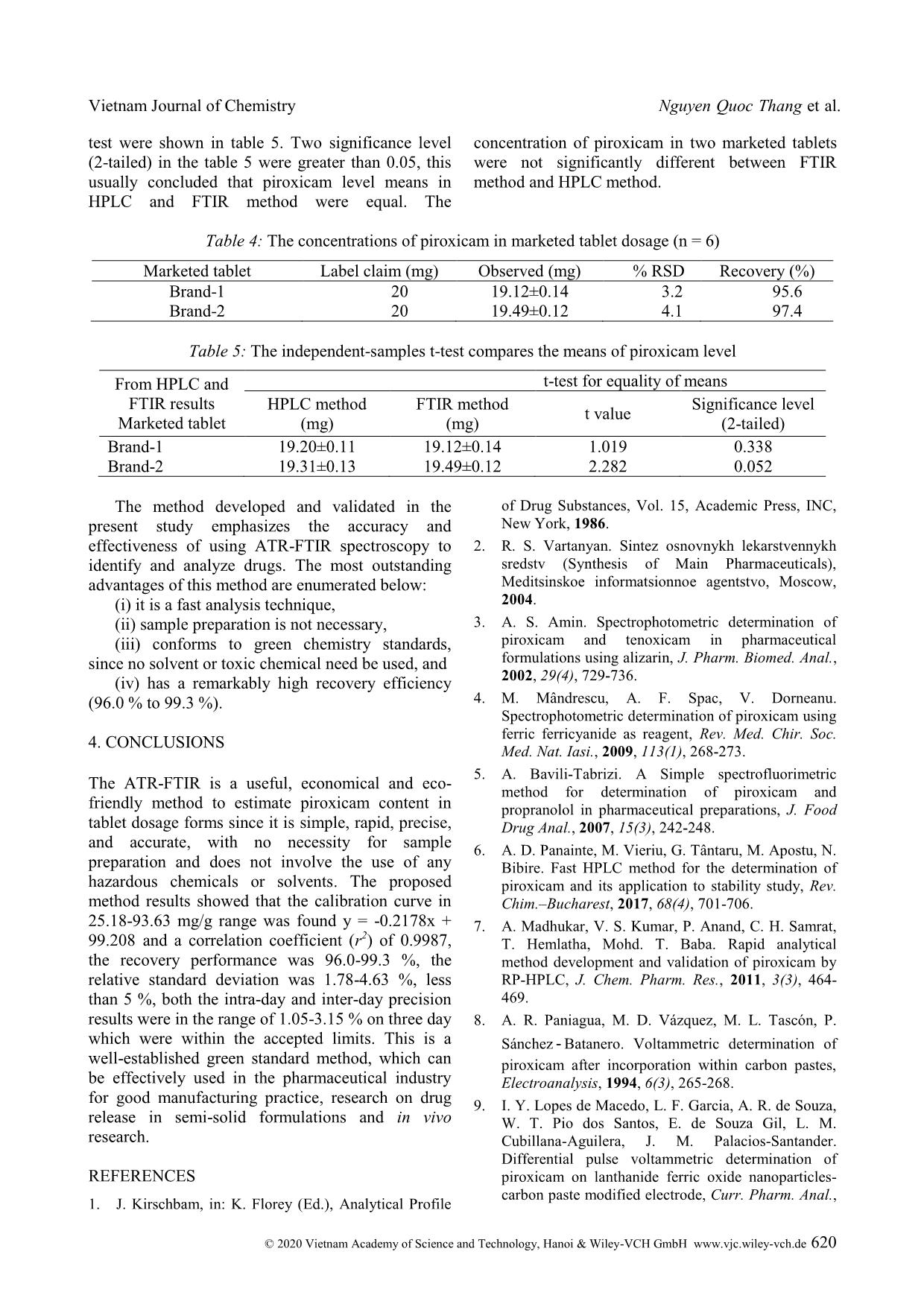
Trang 6
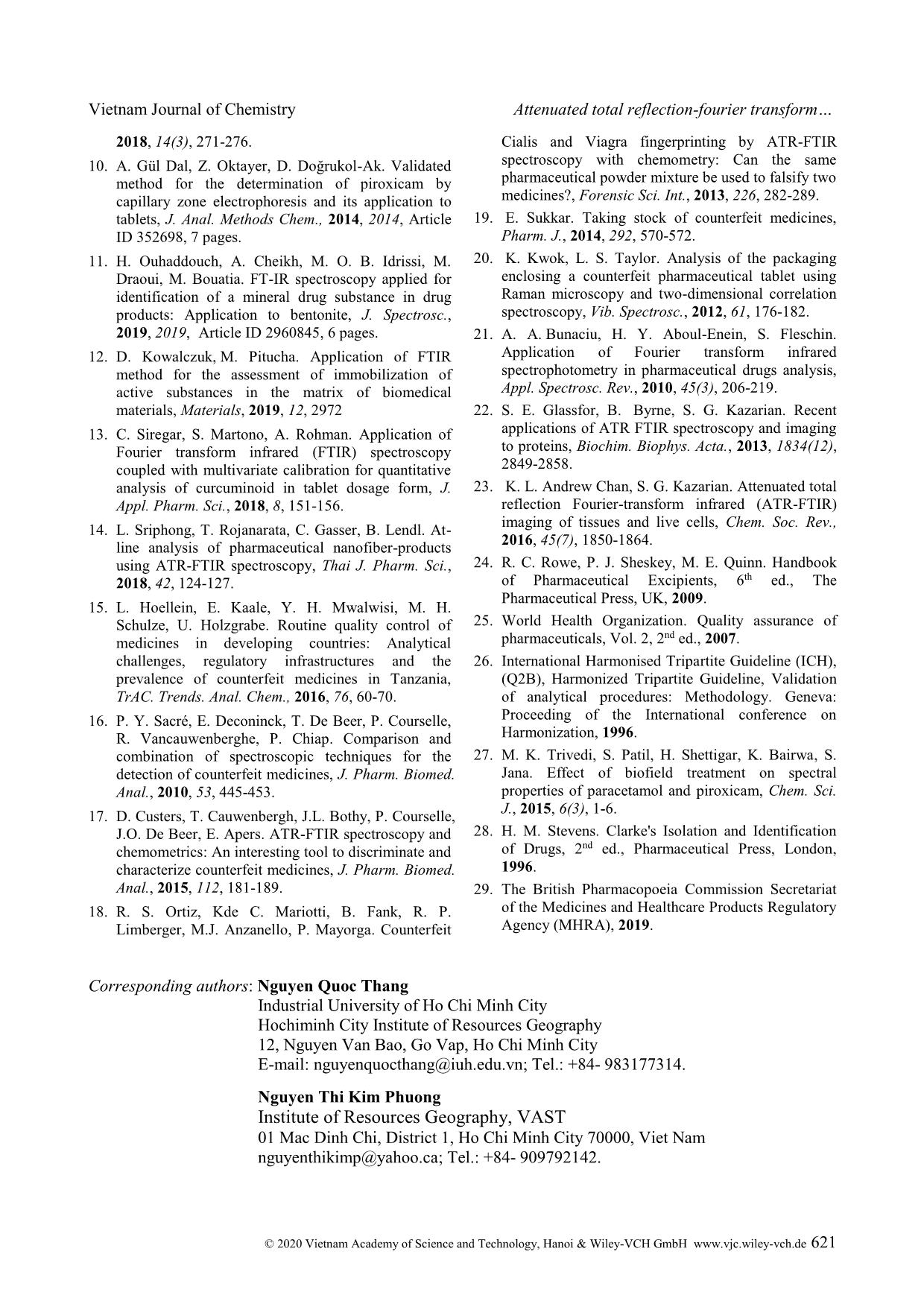
Trang 7
Tóm tắt nội dung tài liệu: Attenuated total reflection-Fourier transform infrared spectroscopy (ATR-FTIR) for quantification of piroxicam in tablet dosage from as a green analytical method
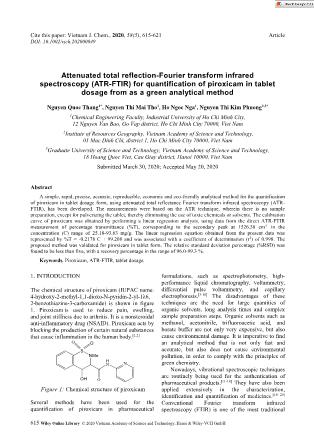
Cite this paper: Vietnam J. Chem., 2020, 58(5), 615-621 Article DOI: 10.1002/vjch.202000049 615 Wiley Online Library © 2020 Vietnam Academy of Science and Technology, Hanoi & Wiley-VCH GmbH Attenuated total reflection-Fourier transform infrared spectroscopy (ATR-FTIR) for quantification of piroxicam in tablet dosage from as a green analytical method Nguyen Quoc Thang1*, Nguyen Thi Mai Tho1, Ho Ngoc Nga1, Nguyen Thi Kim Phuong2,3* 1Chemical Engineering Faculty, Industrial University of Ho Chi Minh City, 12 Nguyen Van Bao, Go Vap district, Ho Chi Minh City 70000, Viet Nam 2Institute of Resources Geography, Vietnam Academy of Science and Technology, 01 Mac Dinh Chi, district 1, Ho Chi Minh City 70000, Viet Nam 3Graduate University of Science and Technology, Vietnam Academy of Science and Technology, 18 Hoang Quoc Viet, Cau Giay district, Hanoi 10000, Viet Nam Submitted March 30, 2020; Accepted May 20, 2020 Abstract A simple, rapid, precise, accurate, reproducible, economic and eco-friendly analytical method for the quantification of piroxicam in tablet dosage form, using attenuated total reflectance Fourier transform infrared spectroscopy (ATR- FTIR), has been developed. The measurements were based on the ATR technique, wherein there is no sample preparation, except for pulverizing the tablet, thereby eliminating the use of toxic chemicals or solvents. The calibration curve of piroxicam was obtained by performing a linear regression analysis, using data from the direct ATR-FTIR measurement of percentage transmittance (%T), corresponding to the secondary peak at 1526.38 cm-1 in the concentration (C) range of 25.18-93.63 mg/g. The linear regression equation obtained from the present data was represented by %T = -0.2178 C + 99.208 and was associated with a coefficient of determination (r2) of 0.998. The proposed method was validated for piroxicam in tablet form. The relative standard deviation percentage (%RSD) was found to be less than five, with a recovery percentage in the range of 96.0-99.3 %. Keywords. Piroxicam, ATR-FTIR, tablet dosage. 1. INTRODUCTION The chemical structure of piroxicam (IUPAC name: 4-hydroxy-2-methyl-1,1-dioxo-N-pyridin-2-yl-1λ6, 2-benzothiazine-3-carboxamide) is shown in figure 1. Piroxicam is used to reduce pain, swelling, and joint stiffness due to arthritis. It is a nonsteroidal anti-inflammatory drug (NSAID). Piroxicam acts by blocking the production of certain natural substances that cause inflammation in the human body.[1,2] Figure 1: Chemical structure of piroxicam Several methods have been used for the quantification of piroxicam in pharmaceutical formulations, such as spectrophotometry, high- performance liquid chromatography, voltammetry, differential pulse voltammetry, and capillary electrophoresis.[3-10] The disadvantages of these techniques are the need for large quantities of organic solvents, long analysis times and complex sample preparation steps. Organic solvents such as methanol, acetonitrile, trifluoroacetic acid, and borate buffer are not only very expensive, but also cause environmental damage. It is imperative to find an analytical method that is not only fast and accurate, but also does not cause environmental pollution, in order to comply with the principles of green chemistry. Nowadays, vibrational spectroscopic techniques are routinely being used for the authentication of pharmaceutical products.[11-18] They have also been applied extensively in the characterization, identification and quantification of medicines.[19, 20] Conventional Fourier transform infrared spectroscopy (FTIR) is one of the most traditional Vietnam Journal of Chemistry Nguyen Quoc Thang et al. © 2020 Vietnam Academy of Science and Technology, Hanoi & Wiley-VCH GmbH www.vjc.wiley-vch.de 616 techniques for identifying pharmaceuticals.[16,17] The use of FTIR requires skilled personnel because preparing samples for a transmission measurement is a rather complex task. The solid samples typically must be pulverized, finely diluted with the IR- inactive KBr and then pressed into KBr-pellets, before analysis. The drawback of this approach is that it is time-consuming, requires continuous drying of KBr, and a hydraulic press to produce uniform KBr pellets. The use of attenuated total reflection (ATR) in combination with the FTIR technique is recommended in order to overcome these limitations. When ATR is used in conjunction with FTIR, samples can be examined straightaway, without further modification. All types of samples, including solids, liquids, powders, pastes, tablets, and fibers can be directly placed on the ATR crystals for measurement. In addition, the ATR-FTIR technique not only measures samples within a few seconds, but also provides excellent data quality, combined with high reproducibility. For these reasons, ATR-FTIR has been widely used as a tool in pharmacological research, pharmaceutical analysis, as well as in other scientific fields in recent years.[21-23] The main objective of this study was to develop a simple, rapid, cost-effective and environment- friendly analytical method for the determination of piroxicam in marketed tablet dosages for routine quality control analysis, based on ATR-FTIR, without using any solvents or toxic chemicals and without any sample handling process. 2. MATERIALS AND METHODS 2.1. Material Pharmaceutical grade piroxicam and placebo were supplied from GLOMED Pharmaceutical Co., Ltd. lactose monohydrate, Plasdone S-630, benzoic acid, magnesium stearate and sodium starch glycolate were purchased from Merck (Darmstadt, Germany). 2.2. Apparatus All spectra were recorded on the Jasco FT/IR-4700 type A spectrophotometer (Japan) equipped with the ATR platinum diamond sampling stage to provide robustness and durability. The FTIR spectra we ... coefficient (r2) 0.9987 Standard error of regression 3.18% Thus, ATR-FTIR method is completely aligned with the principles of green chemistry. That is, the piroxicam content can be evaluated, without the use of any solvent, whatsoever. To assess the linearity of the calibration curve, piroxicam was thoroughly mixed with powdered excipients. The piroxicam concentration was then analyzed in the range of 25.18–93.63 mg/g in triplicates. The calibration curve in this range was found to be linear, with the regression equation given by y = -0.2178x + 99.208 and a correlation coefficient (r2) of 0.9987 (see Figure 3 and Table 1). This regression equation was later used to estimate the concentration of piroxicam in the real samples. Figure 3: (a) Transmittance spectra and (b) calibration curve for the piroxicam concentration in the range of 25.18-93.63 mg/g The precision of the method was expressed as the percentage of the relative standard deviation (%RSD). Repeatability was checked with multiple measurements of the spectrum over three days of two distinct types of piroxicam samples (standard and tablet) at a concentration of 20 mg, with subsequent calculation of the % RSD. These intra- day and inter-day experiments were performed under the same operating conditions, in the same laboratory, for the same time period. As can be seen in table 2, the % RSD values for the precision studies are in the range of 2.53-3.15 % on day 1, 1.05-1.92 % on day 2 and 1.36-2.84 on day 3. Both the intra-day and inter-day precision results were within the accepted limits, in accordance with ICH guidelines. The most common way to evaluate the accuracy of a proposed technique is the spike recovery method. In the present study, a known quantity of piroxicam (10.0, 15.0 or 20.0 mg) was spiked into Vietnam Journal of Chemistry Attenuated total reflection-fourier transform © 2020 Vietnam Academy of Science and Technology, Hanoi & Wiley-VCH GmbH www.vjc.wiley-vch.de 619 excipients. By comparing the amount of piroxicam found and the amount of piroxicam spiked, the recovery efficiency of the present method was calculated. The statistics of piroxicam recovery studies are compiled in table 3. The results indicate a high recovery performance (96.0-99.3 %) with an excellent %RSD (1.78-4.63 %) of the proposed method, which are within acceptable limits as specified by ICH guidelines. Furthermore, the recovery percentage values obtained here indicate that there is no significant interference effect from any excipient present in the matrix. This also implies that the method proposed here can be used to estimate the content of piroxicam, without any need for without solvent extraction. Compare to the result of reversed-phase high- performance liquid chromatographic (RP-HPLC) method for the determination of piroxicam in tablets. Table 2: Results for the evaluation of precision of piroxicam (n = 6) Sample Amount added (mg) Day 1 Day 2 Day 3 Amount found (mg) % RSD Amount found (mg) % RSD Amount found (mg) % RSD Standard 20.0 19.80±0.62 3.15 19.67±0.38 1.92 19.37±0.55 2.84 Tablet 20.0 19.87±0.50 2.53 19.73±0.21 1.05 19.50±0.26 1.36 Table 3: Recovery results of piroxicam from spiked samples (n = 5) Excipient (mg) Added amount (mg) Found amount (mg) Recovery (%) % RSD 387.8 10.0 9.63±0.25 96.3 2.61 386.4 10.2 9.80±0.26 96.1 2.70 387.5 10.2 9.90±0.46 97.1 4.63 387.1 15.1 14.90±0.30 98.7 2.01 386.7 15.2 15.00±0.30 98.7 2.00 387.9 14.9 14.80±0.30 99.3 2.03 387.2 20.0 19.73±0.35 98.5 1.78 386.9 20.1 19.27±0.42 96.0 2.16 387.8 20.2 19.53±0.40 96.5 2.07 3.2. Quantification of piroxicam in marketed tablet dosage The ATR-FTIR method developed and validated in this study was used to determine the quantity of piroxicam present in two different marketed brands. The results are summarized in table 4. The persistence of the peak around 1526 cm-1 in the FTIR spectrum of the marketed tablet dosages (see figure 4) confirmed that there was no significant interference due to the presence of excipients. The average recoveries of piroxicam in the two marketed tablet dosages are in the range of 95.6-97.4 % of what was claimed on the labels, with %RSD values in the range of 3.2-4.1 %. The recovery percentage of piroxicam is within acceptable limits (95-105 % in The British Pharmacopoeia Commission Secretariat of the Medicines and Healthcare Products Regulatory Agency).[29] This study demonstrates that the simple ATR-FTIR approach employed has the capacity to rapidly identify, as well as estimate piroxicam content in the presence of excipients. The whole process of crushing, identifying and quantifying the piroxicam content of a tablet would take about three minutes per tablet sample. Figure 4: FTIR spectrum of piroxicam in marketed tablet dosage The piroxicam level in two different marketed brands were determined using HPLC and FTIR method and the results of the independent-samples t- Vietnam Journal of Chemistry Nguyen Quoc Thang et al. © 2020 Vietnam Academy of Science and Technology, Hanoi & Wiley-VCH GmbH www.vjc.wiley-vch.de 620 test were shown in table 5. Two significance level (2-tailed) in the table 5 were greater than 0.05, this usually concluded that piroxicam level means in HPLC and FTIR method were equal. The concentration of piroxicam in two marketed tablets were not significantly different between FTIR method and HPLC method. Table 4: The concentrations of piroxicam in marketed tablet dosage (n = 6) Marketed tablet Label claim (mg) Observed (mg) % RSD Recovery (%) Brand-1 20 19.12±0.14 3.2 95.6 Brand-2 20 19.49±0.12 4.1 97.4 Table 5: The independent-samples t-test compares the means of piroxicam level From HPLC and FTIR results Marketed tablet t-test for equality of means HPLC method (mg) FTIR method (mg) t value Significance level (2-tailed) Brand-1 19.20±0.11 19.12±0.14 1.019 0.338 Brand-2 19.31±0.13 19.49±0.12 2.282 0.052 The method developed and validated in the present study emphasizes the accuracy and effectiveness of using ATR-FTIR spectroscopy to identify and analyze drugs. The most outstanding advantages of this method are enumerated below: (i) it is a fast analysis technique, (ii) sample preparation is not necessary, (iii) conforms to green chemistry standards, since no solvent or toxic chemical need be used, and (iv) has a remarkably high recovery efficiency (96.0 % to 99.3 %). 4. CONCLUSIONS The ATR-FTIR is a useful, economical and eco- friendly method to estimate piroxicam content in tablet dosage forms since it is simple, rapid, precise, and accurate, with no necessity for sample preparation and does not involve the use of any hazardous chemicals or solvents. The proposed method results showed that the calibration curve in 25.18-93.63 mg/g range was found y = -0.2178x + 99.208 and a correlation coefficient (r2) of 0.9987, the recovery performance was 96.0-99.3 %, the relative standard deviation was 1.78-4.63 %, less than 5 %, both the intra-day and inter-day precision results were in the range of 1.05-3.15 % on three day which were within the accepted limits. This is a well-established green standard method, which can be effectively used in the pharmaceutical industry for good manufacturing practice, research on drug release in semi-solid formulations and in vivo research. REFERENCES 1. J. Kirschbam, in: K. Florey (Ed.), Analytical Profile of Drug Substances, Vol. 15, Academic Press, INC, New York, 1986. 2. R. S. Vartanyan. Sintez osnovnykh lekarstvennykh sredstv (Synthesis of Main Pharmaceuticals), Meditsinskoe informatsionnoe agentstvo, Moscow, 2004. 3. A. S. Amin. Spectrophotometric determination of piroxicam and tenoxicam in pharmaceutical formulations using alizarin, J. Pharm. Biomed. Anal., 2002, 29(4), 729-736. 4. M. Mândrescu, A. F. Spac, V. Dorneanu. Spectrophotometric determination of piroxicam using ferric ferricyanide as reagent, Rev. Med. Chir. Soc. Med. Nat. Iasi., 2009, 113(1), 268-273. 5. A. Bavili-Tabrizi. A Simple spectrofluorimetric method for determination of piroxicam and propranolol in pharmaceutical preparations, J. Food Drug Anal., 2007, 15(3), 242-248. 6. A. D. Panainte, M. Vieriu, G. Tântaru, M. Apostu, N. Bibire. Fast HPLC method for the determination of piroxicam and its application to stability study, Rev. Chim.–Bucharest, 2017, 68(4), 701-706. 7. A. Madhukar, V. S. Kumar, P. Anand, C. H. Samrat, T. Hemlatha, Mohd. T. Baba. Rapid analytical method development and validation of piroxicam by RP-HPLC, J. Chem. Pharm. Res., 2011, 3(3), 464- 469. 8. A. R. Paniagua, M. D. Vázquez, M. L. Tascón, P. Sánchez ‐Batanero. Voltammetric determination of piroxicam after incorporation within carbon pastes, Electroanalysis, 1994, 6(3), 265-268. 9. I. Y. Lopes de Macedo, L. F. Garcia, A. R. de Souza, W. T. Pio dos Santos, E. de Souza Gil, L. M. Cubillana-Aguilera, J. M. Palacios-Santander. Differential pulse voltammetric determination of piroxicam on lanthanide ferric oxide nanoparticles- carbon paste modified electrode, Curr. Pharm. Anal., Vietnam Journal of Chemistry Attenuated total reflection-fourier transform © 2020 Vietnam Academy of Science and Technology, Hanoi & Wiley-VCH GmbH www.vjc.wiley-vch.de 621 2018, 14(3), 271-276. 10. A. Gül Dal, Z. Oktayer, D. Doğrukol-Ak. Validated method for the determination of piroxicam by capillary zone electrophoresis and its application to tablets, J. Anal. Methods Chem., 2014, 2014, Article ID 352698, 7 pages. 11. H. Ouhaddouch, A. Cheikh, M. O. B. Idrissi, M. Draoui, M. Bouatia. FT-IR spectroscopy applied for identification of a mineral drug substance in drug products: Application to bentonite, J. Spectrosc., 2019, 2019, Article ID 2960845, 6 pages. 12. D. Kowalczuk, M. Pitucha. Application of FTIR method for the assessment of immobilization of active substances in the matrix of biomedical materials, Materials, 2019, 12, 2972 13. C. Siregar, S. Martono, A. Rohman. Application of Fourier transform infrared (FTIR) spectroscopy coupled with multivariate calibration for quantitative analysis of curcuminoid in tablet dosage form, J. Appl. Pharm. Sci., 2018, 8, 151-156. 14. L. Sriphong, T. Rojanarata, C. Gasser, B. Lendl. At- line analysis of pharmaceutical nanofiber-products using ATR-FTIR spectroscopy, Thai J. Pharm. Sci., 2018, 42, 124-127. 15. L. Hoellein, E. Kaale, Y. H. Mwalwisi, M. H. Schulze, U. Holzgrabe. Routine quality control of medicines in developing countries: Analytical challenges, regulatory infrastructures and the prevalence of counterfeit medicines in Tanzania, TrAC. Trends. Anal. Chem., 2016, 76, 60-70. 16. P. Y. Sacré, E. Deconinck, T. De Beer, P. Courselle, R. Vancauwenberghe, P. Chiap. Comparison and combination of spectroscopic techniques for the detection of counterfeit medicines, J. Pharm. Biomed. Anal., 2010, 53, 445-453. 17. D. Custers, T. Cauwenbergh, J.L. Bothy, P. Courselle, J.O. De Beer, E. Apers. ATR-FTIR spectroscopy and chemometrics: An interesting tool to discriminate and characterize counterfeit medicines, J. Pharm. Biomed. Anal., 2015, 112, 181-189. 18. R. S. Ortiz, Kde C. Mariotti, B. Fank, R. P. Limberger, M.J. Anzanello, P. Mayorga. Counterfeit Cialis and Viagra fingerprinting by ATR-FTIR spectroscopy with chemometry: Can the same pharmaceutical powder mixture be used to falsify two medicines?, Forensic Sci. Int., 2013, 226, 282-289. 19. E. Sukkar. Taking stock of counterfeit medicines, Pharm. J., 2014, 292, 570-572. 20. K. Kwok, L. S. Taylor. Analysis of the packaging enclosing a counterfeit pharmaceutical tablet using Raman microscopy and two-dimensional correlation spectroscopy, Vib. Spectrosc., 2012, 61, 176-182. 21. A. A. Bunaciu, H. Y. Aboul-Enein, S. Fleschin. Application of Fourier transform infrared spectrophotometry in pharmaceutical drugs analysis, Appl. Spectrosc. Rev., 2010, 45(3), 206-219. 22. S. E. Glassfor, B. Byrne, S. G. Kazarian. Recent applications of ATR FTIR spectroscopy and imaging to proteins, Biochim. Biophys. Acta., 2013, 1834(12), 2849-2858. 23. K. L. Andrew Chan, S. G. Kazarian. Attenuated total reflection Fourier-transform infrared (ATR-FTIR) imaging of tissues and live cells, Chem. Soc. Rev., 2016, 45(7), 1850-1864. 24. R. C. Rowe, P. J. Sheskey, M. E. Quinn. Handbook of Pharmaceutical Excipients, 6th ed., The Pharmaceutical Press, UK, 2009. 25. World Health Organization. Quality assurance of pharmaceuticals, Vol. 2, 2nd ed., 2007. 26. International Harmonised Tripartite Guideline (ICH), (Q2B), Harmonized Tripartite Guideline, Validation of analytical procedures: Methodology. Geneva: Proceeding of the International conference on Harmonization, 1996. 27. M. K. Trivedi, S. Patil, H. Shettigar, K. Bairwa, S. Jana. Effect of biofield treatment on spectral properties of paracetamol and piroxicam, Chem. Sci. J., 2015, 6(3), 1-6. 28. H. M. Stevens. Clarke's Isolation and Identification of Drugs, 2nd ed., Pharmaceutical Press, London, 1996. 29. The British Pharmacopoeia Commission Secretariat of the Medicines and Healthcare Products Regulatory Agency (MHRA), 2019. Corresponding authors: Nguyen Quoc Thang Industrial University of Ho Chi Minh City Hochiminh City Institute of Resources Geography 12, Nguyen Van Bao, Go Vap, Ho Chi Minh City E-mail: nguyenquocthang@iuh.edu.vn; Tel.: +84- 983177314. Nguyen Thi Kim Phuong Institute of Resources Geography, VAST 01 Mac Dinh Chi, District 1, Ho Chi Minh City 70000, Viet Nam nguyenthikimp@yahoo.ca; Tel.: +84- 909792142.
File đính kèm:
 attenuated_total_reflection_fourier_transform_infrared_spect.pdf
attenuated_total_reflection_fourier_transform_infrared_spect.pdf

